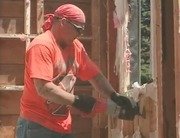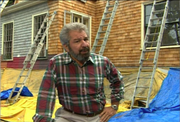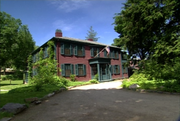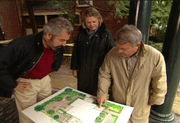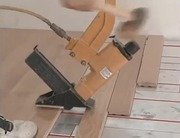Well, that visit took place a couple of weeks ago, when the sun was shining, and things around here are getting very wet.
But let's meet Mark Marini from Schumacher Landscape Construction.
Hi, Mark.
How ya doing, Bob?
Well, it's been better, right?
This is not the ideal weather for landscape construction but you've already done all the preliminary work, right?
Yes.
We removed all the loam from the back yard.
About 12 inches or so.
We brought back some crusher run gravel as a base material for the blue stone pavement.
So how deep is that?
It's 12 inches deep.
So there's 12 inches of crusher run, and then how much stone dust do you put down?
We put down about an inch of stone dust as the base for the blue stone paving.
Okay, so you don't want to have more than an inch?
Well, you can go to an inch and a half or so, but you want to keep it a pretty thin layer.
Right.
Now, the plan is for a rectangular terrace that runs the whole width of the house but there is a cut out here for for some plantings a square this five by five, right?
Yes.
And another one down there for a little tree?
That's right.
And you have gotten started here.
It looks beautiful.
Well, we got a start on it before the weather.
But the bluestone is starting to go in, but we had to stop.
The rain is just too much for it right now.
Yeah.
When everything gets saturated like this, obviously you can not do the installation because it wouldn't come out right.
It just doesn't sit right.
What kind of bluestone is this?
I know it's a lilac color, right?
It's a lilac color, comes from New York.
Usually bluestone is a blue-gray color, but this is a nice change.
It'll be very pleasant against the house when it's finished.
But what are we going to do?
Are you going to have to break for a day or so?
Yeah.
We're going to have to let it dry out for a day.
See what happens and hopefully get back to it in a day or so.
Well, thanks Mark.
I know we'll be here to watch.
Okay, it's taken Forty eight hours for the rain to stop and the site to dry out, but you can see just today, we've made a lot of progress laying out this area.
And before we continue, I wanted to kind of take a close look at what you've done here, because this is the blueprint that the landscape architect gives you, from which you put together a bit on the work as well as figure out how the works going to be done.
Can you explain what you've done here with all the colors and stuff?
Well sure.
When we get the plan from the landscape architect, of course, we bring it in the office, and we review it.
Every corner of the site has to be detailed so that we can plan the project and start at the hard-scape in the furthest corner, and work our way through this back terrace here.
Yeah.
This is the whole back terrace, back here.
We just walked across over in this direction.
We're standing right here now.
Yeah.
When we're in the office, we'll color up the plan for the foreman in the field so he can pick out each item of work quickly, and easily and identify everything.
as he goes through the projects so he can plan is work for each day.
And right now, we're still in Hardscape.
We've been delayed by weather.
Next week, hopefully, we'll be putting in beautiful plant specimens.
But, right now, lets, lets look at this cause its, it's what called random pattern.
Is there, is there some logic to it?
No, only you start on an edge as you work your way in.
You just want to watch your joints to make sure you don't have no joints that are too long.
You want to watch to make sure you don't get four corners to come together anywhere.
And in some areas it does, lay out 4 against 1.
You've got 1 stone here with four stones up against it.
Right.
Is that just coincidence or is that...?
No.
You have to make up some of these points every once in a while with a smaller stone so that you're not carrying long joints for too, for too long.
OK.
And of course, we reviewed earlier how you've got an inch, inch and a half of the stone dust And the pieces get put down, shall we grab another one?
Sure.
They're not, if they're small they're not too heavy.
No, this is not right.
No, it's not going to work, because the 4 corners come together here.
Right.
And it really doesn't give a good look, so we'd gonna want to turn this a little bit.
So, you want to turn it the other way and now, will it actually tamp down that much there's a good quarter inch difference there, right?
Yeah, once you get it to a about eighth of an inch, you'll be able to tamp it down with a setting hammer.
Sometimes it'll work when you first set the stone in, but many has to take some of the material away.
Okay.
And one of the things I remember discussing with the landscape architects, was the width of our joints in between and we talked about a pencil width kind of, and the idea being that I, I like the effect of the weather and moss starting to grow in between and stuff as the years go by and the best way to encourage that is to have a good quarter inch joint.
Right.
If you leave a joint in there, you can set in some stone that sleeping into the joint and you do get mass growing in the joint later on.
Good, that's going right down, lets pick up another one.
How about that big one over here, OK?
This way?
Yeah.
OK, and we've made quite a bit of progress.
Now, this get's back to what we were talking about in the plan.
What have you done here?
Well, there's a planting event for the Thundercloud Plum, and it's going to be coming in next week.
So we got to excavate the hole four feet deep and put in loam.
And fill it up with loam, nice green loam.
OK.
OK, well we're almost at the end of the terrace, and what are we doing here?
Well, we found a stone that has a bad corner.
And we don't want to waste anything, so we're going to use it.
We just have to make a cut on it.
We can still use the best part of the stone and come back to this joint here, and just make this one cut.
Alright, is that just a carborundum blade that Manny has there?
Yes.
OK.
Let's watch.
Boy, this is exiting.
We've just condensed that but in real time it really only took about two minutes for Manny to cut right through there, and now it just has to be fitted out a little bit.
But we're almost done here, aren't we?
Yes, I mean we'll be done in about another hour, finish the last few pieces.
The last few pieces that go in here.
And then do we have to add stone?
Dust to the top of it and sweep it around to get it into the cracks.
Yes, after we arrange the joints, we'll sweep in stone dust.
And this should last for centuries, right?
Right, thanks a lot Mark.
Okay, We are running out of time.
Next week I hope you'll be able to join us because we are going be busy out in the landscape again.
We're going to be planting this wonderful plum tree.
And looking at some other material, I hope.
Also taking you down to Andler, Pennsylvania, where we'll be visiting the Burpee Trial Gardens, where they have all sorts of exciting stuff to look at.
And inside the house the kitchen cabinets are in place so we are going to be talking about it installing soap stone counters.
Till then, I am Bob Vila.
We are running out of time.
Its good to have you home again.

